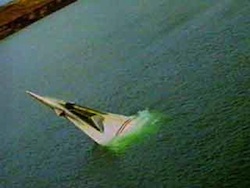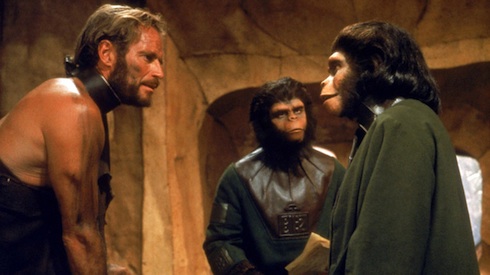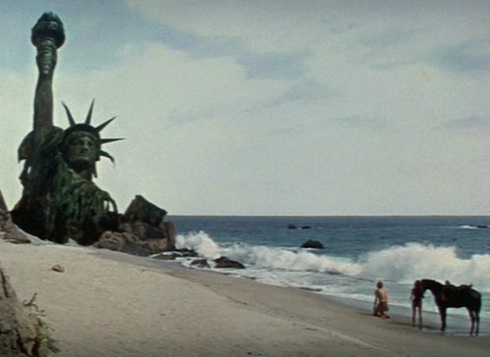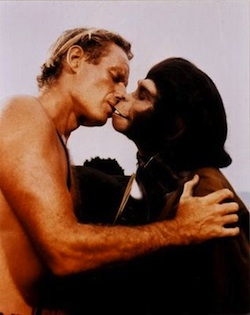Like a lot of cult genre films, the original Planet of the Apes doesn’t get taken as seriously as maybe it should. Unlike arguably all of its sequels, the first Apes movie is special, and you feel like you’re watching something totally unique from the first scene. To me, the filmmakers did their best to honor the source material, but also realized a lot of the novel simply wouldn’t work as a movie. Instead, it looks like everyone decided not to make an exclusively political film, but instead combine that social commentary with an hour and half long version of a Twilight Zone episode. (Rod Serling co-wrote the screenplay after all!) And the result was a great movie that feels just as daring and new now as it must have in 1968.
Right from the onset of the film, Charlton Heston’s Col. George Taylor is not your average whitebread U.S. Space Explorer. Smoking a little cigar in his spaceship, Taylor records a ship’s log in which he bemoans the behavior of humanity over the years. Taylor is a humorously cynical guy who knows humans are pretty much the worst thing ever, and as a result; he’s gone out into space with an ulterior motive of finding something better. Taylor’s spaceship is a sleeper ship with its entire crewmember in suspended animation except for him. Soon, he puts himself under too, and the story really gets going.
 The ship crashes onto what seems to be an alien world. After the disaster, all but Taylor and two other crew members are alive. They’ve determined that not only are they on another planet, but have also traveled thousands of years in the future. Taylor doesn’t seem to have a big problem with this and almost immediately starts chiding his colleagues for feeling any emotional pangs in relation to their friends and family back on Earth. He takes out his little cigar and essentially starts telling them to get over it. He also mocks one of the other guys when he plants a small American flag in the soil. Taylor knows the idea of claiming another planet for your country is absurd and has a really good laugh. Being made in 1968, this movie came out BEFORE the moon landing and was basically making fun of the jingoism of claiming other worlds for any specific country. The fact that the flag is really tiny drives this point home. Pretty risky stuff for a movie of its time!
The ship crashes onto what seems to be an alien world. After the disaster, all but Taylor and two other crew members are alive. They’ve determined that not only are they on another planet, but have also traveled thousands of years in the future. Taylor doesn’t seem to have a big problem with this and almost immediately starts chiding his colleagues for feeling any emotional pangs in relation to their friends and family back on Earth. He takes out his little cigar and essentially starts telling them to get over it. He also mocks one of the other guys when he plants a small American flag in the soil. Taylor knows the idea of claiming another planet for your country is absurd and has a really good laugh. Being made in 1968, this movie came out BEFORE the moon landing and was basically making fun of the jingoism of claiming other worlds for any specific country. The fact that the flag is really tiny drives this point home. Pretty risky stuff for a movie of its time!
Having three astronauts set out to explore the surface of the mysterious planet is actually very similar to the beginning of the novel. Indeed, the basic structure of the plot, in terms of how things unfold and how things change in the story are extremely similar to the novel, which feels sort of shocking when one considers the major changes made to the basic premise. After taking a naked dip in a pond (Heston’s naked butt!) our astronauts have their clothes stolen by the wild humans who reside on this planet. As in the novel, these humans lack speech and run around like wild animals. Soon a platoon of aggressive, clothed gun-toting gorillas show up and starts slaughtering the wild humans. One of Taylor’s companions is killed while the other is captured but taken somewhere separate from Taylor. Once in captivity, Taylor attracts the attention of female chimpanzee scientist Zira(Kim Hunter) who begins calling him “bright eyes” a reference to both the bright blue color of Heston’s eyes but also to the spark of individuality she sees there.
The “bright eyes” motif is actually one of the changes from the book to the film that I truly love. This single line of sentimentality strengthens the bond between Taylor and Zira. In the novel, the tenderness between Zira and Ulysse was there and the film not only does it justice, it improves on that tenderness.

The plot proceeds similar to the novel with Taylor eventually drawing a diagram on a paper to indicate to Zira he is truly intelligent. With the help of her fiancé Cornelius (Roddy McDowall) Taylor eventually convinces the other apes that he is intelligent. Still, chaos ensues as evidence starts to surface that the intelligent apes might have evolved from humans like Taylor, a notion the organtan Dr. Zaius (Maurice Evans) would like to quietly put away. It’s notable here that Planet of the Apes doesn’t really have any villains outright. Certainly Dr. Zaius is repressing information and screwing over Taylor. But he’s not necessarily a bad person, in fact by the end of the film Dr. Zaius seems to pity Taylor and tries to warn him against discovering the terrible truth about the world. Taylor on the other hand becomes fairly violent, proving to the apes that he is indeed and in fact just as dangerous as the non-speaking savage humans. Taylor, in the end, embodies the very qualities he sought to leave behind on this space voyage.
The only aspect of the film that feels a little tacked on is a random adolescent ape named Lucius who is introduced towards the end of the film. Taylor exchanges some pretty corny comments with Lucius like “don’t trust anyone under 30.” This is the only stuff that really dates the film and grounds it in its sixties-ness a little too much. The Lucius character is supposed to be Zira and Cornelius’s nephew, and my suspicion is that the young actor who played Lucius was probably some studio executive’s nephew in real life. Fortunately, Lucius isn’t around for much of the film, allowing the universal poignancy of what is going to outshine any hammy over-the-top topical messages.
The importance of Taylor’s human girlfriend Nova (Linda Harrison) is downplayed somewhat in this version of Apes. She doesn’t become pregnant as in the novel, and most of the apes regard her as something of a nuisance. I imagine it was hard to convey the subtly that existed in the book. Uylsse both desired Nova on a basic animalistic level, but also pitied her for her primitive behavior. He was also a little grossed out by her. In the film, you sort of get the impression that Taylor just thinks she’s hot.

Famously, the film ends with the massive revelation that Taylor has been on Earth the entire time. Even if you know this twist is coming, the revelation that the Statue of Liberty is buried in the sand, and that this Earth was brought about by some kind of atomic fallout is a fantastic one. Taylor, the cynic and self-loathing human being collapses in anguish in the sand and delivers his famous “Damn them, damn them all to hell!” line which never ceases to send a little shiver up my spine. In Taylor’s eyes, in the final moments of the film, contemporary humans of contemporary Earth are cast as the villains. It’s a fantastically dark ending to a complex and interesting movie that could have just been a silly romp about talking monkeys.
Did the ending of Planet of the Apes truly beg for a sequel? Not really. It certainly feels like the point of the story has been achieved. The audience doesn’t really want to know what happens to Taylor, Zira, Cornelius and everybody after this. And yet, there were four more Apes films!
Up next, Beneath the Planet of the Apes brings back ALL the main characters from the first film. But there’s just one question, where is Heston hiding, and who is this guy who looks exactly like him?
Ryan Britt is a staff writer for Tor.com. His favorite character in the films is Zira. Ryan loves Zira.










